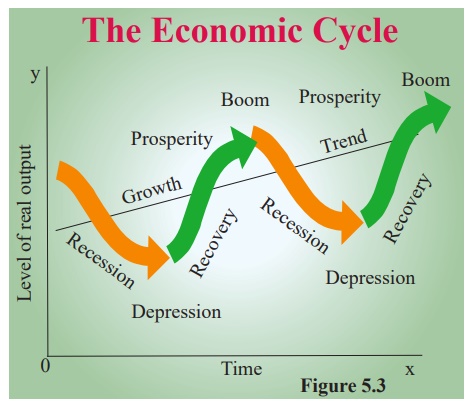Monetary Economics - Trade Cycle | 12th Economics : Chapter 5 : Monetary Economics
Chapter: 12th Economics : Chapter 5 : Monetary Economics
Trade Cycle
Trade Cycle
The economic activity in a capitalist economy will have its
periodic ups and downs. The study of these ups and downs is called the study of
Business cycle or Trade cycle or Industrial Fluctuation.
1. Meaning of Trade Cycle
A Trade cycle refers to oscillations in aggregate economic
activity particularly in employment, output, income, etc. It is due to the
inherent contraction and expansion of the elements which energize the economic
activities of the nation. The fluctuations are periodical, differing in
intensity and changing in its coverage.
Definition
“A trade cycle is composed of periods of good trade characterised
by rising prices and low unemployment percentages altering with periods of bad
trade characterised by falling prices and high unemployment percentages”. -
J.M. Keynes
2. Phases of Trade Cycle
The four different phases of trade cycle is referred to as (i)
Boom (ii) Recession (iii) Depression and (iv) Recovery. These are illustrated
in the Figure 5.3.
Phases of Trade Cycle

i) Boom or Prosperity Phase: The full employment and the movement of
the economy beyond full employment is characterized as boom period. During this
period, there is hectic activity in economy. Money wages rise, profits increase
and interest rates go up. The demand for bank credit increases and there is
all-round optimism.
ii) Recession: The turning point from boom condition is
called recession. This happens at higher rate, than what was earlier.
Generally, the failure of a company or bank bursts the boom and brings a phase
of recession. Investments are drastically reduced, production comes down and
income and profits decline. There is panic in the stock market and business
activities show signs of dullness. Liquidity preference of the people rises and
money market becomes tight.
iii) Depression: During depression the level of economic
activity becomes extremely low. Firms incur losses and closure of business
becomes a common feature and the ultimate result is unemployment. Interest
prices, profits and wages are low. The agricultural class and wage earners
would be worst hit. Banking institutions will be reluctant to advance loans to
businessmen. Depression is the worst phase of the business cycle. Extreme point
of depression is called as “trough”, because it is a deep point in business cycle.
Any person fell down in deeps could not come out from that without other’s
help. Similarly, an economy fell down in trough could not come out from this
without external help. Keynes advocated that autonomous investment of the
government alone can help the economy to come out from the depression.
iv) Recovery: After a period of depression, recovery sets in. This is the
turning point from depression to revival towards upswing. It begins with the
revival of demand for capital goods. Autonomous investments boost the activity.
The demand slowly picks up and in due course the activity is directed towards
the upswing with more production, profit, income, wages and employment.
Recovery may be initiated by innovation or investment or by government
expenditure (autonomous investment).
Related Topics